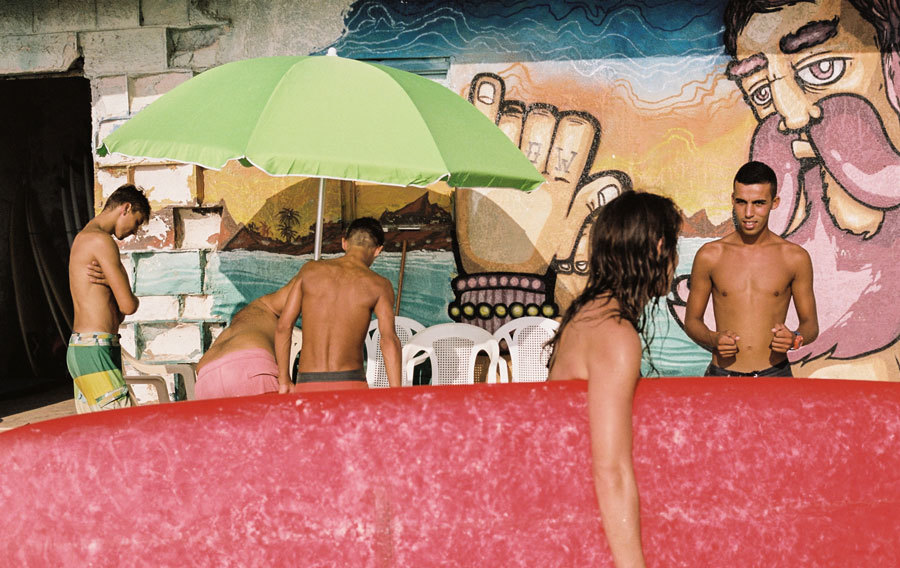“Mustafa was the first surfer of Jiyeh, the one who proved that waves were precious gems belonging to all of us,” says Ali, a 40-year-old surfer I photographed before he jumped in the water. “I was up the road looking for this spot when I met him. He showed me the way and since then, he is like my little brother, like all the kids who grew up here.”
This path to the water follows a row of greenhouses from which comes the superfluous smell of manure. At the end is the beach, covered in multi-colored umbrellas under which some shisha-smokers shelter, drinking soda. To the left, a factory is full of activity, black smoke blowing. The surf spot is on the right, alongside an artificial dam concealing a luxury hotel and a marina. A dozen of surfers are out on the breaking waves.

Most of them stay in the water all day long while others come and go, resting next to the hut where they store their boards — Mustafa’s hut. Leaning on a wall, a bunch of Lebanese youth laugh while keeping an eye on the waves. Another small group sit on a van looking them same direction. “We’re waiting for the end of the session,” says one of them, “when the sun sets, the sea is more quiet and the waves are better.”

If there are a lot of people surfing today it’s because good summer sessions are rare. “In the winter it’s better, the waves are almost seven feet high,” explains Alfred, a regular surfer here. “This place is the best in Lebanon, the waves are more consistent than in the rest of the country.” I discovered this spot through Alfred, who surfs in his spare time when he’s not busy with his graphic design job in Beirut. He’s the one who painted the surf hut. He’s also Mustafa’s friend but couldn’t introduce him to me because he was working. “I know every single surfer here,” he says. Actually they all know each other, young and old, boys and girls, Christians and Muslims, Sunnis and Shia — they all hang out together in the water and on the beach. This is not the case throughout Lebanon. “You can meet people from every background on the beach, from different religions, communities, and social statuses,” confirms Alfred.

A few weeks later I finally got to meet Mustafa, the man who can tell me the most about the Jiyeh. When I asked why he likes it here he answered, “This is my village, I was born here, my father, my grandfather, his father before him were all born here.” He explained that he started surfing in 1996 at the age of 12, after meeting a French guy named Didier who left him his board when he returned to France. A few days later Mustafa took the keys to his cousin’s seafront apartment and began surfing.

This small beach, mostly frequented by local families, demonstrates that the conflicts of religion are not everywhere in this part of the world. Here, even though you can find surfing girls wearing burkinis, and a mosque less than 300 feet from the beach, everyone respects one another. “Some people think we are terrorists because we are Shia and consequently linked with Hezbollah. But you see who we really are,” says Mustafa. This place brings people together beyond the divide of belief, dogmas, and tradition.

Here, far away from the deafening noise of Beirut, Lebanese people from the city and the countryside are brought together. This little surprising paradise, dirty and chaotic, doesn’t look like what most imagine the ideal to be. Palm trees, white sand, flowers, and seashells are far from here. The beauty of this place comes from something we can’t immediately see. The kids playing with a horse in the water, women walking on the seaside, the group of surfers hanging around all day long. As the day darkens the young surfers from the van join the group still in the water, surfing one last time before winter. “Every time I come to the beach, I am relieved. It is the only place where I truly feel good,” says Mustafa.

Credits
Text and photography Charles Thiefaine
